“Turn Left at the Causeway” – A Preservation Story
28 Nov 2019
by Gwen McCauley (Nature Trust Volunteer)
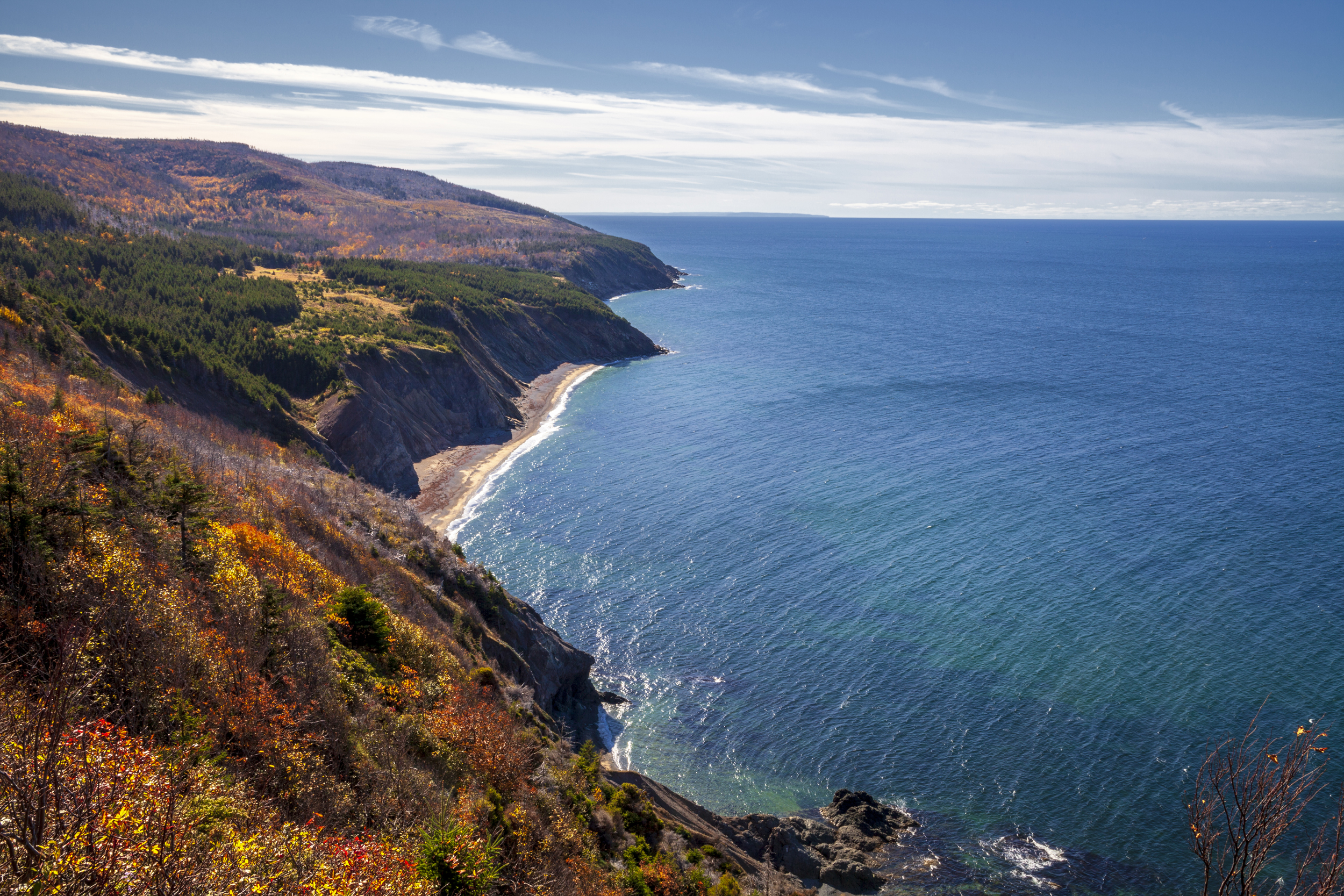
Sight Point in the Mabou Highlands, looking towards MacKinnons Brook. Photo: Irwin Barrett
On an island noted for its beautiful vistas, people who’ve been to the Mabou Highlands claim that it offers the most beautiful of the beautiful! Whether by design, oversight or simple expediency due to the wildly rugged terrain of the area, the main road around Cape Breton veers significantly inland in this region, leaving a vast expanse of mountain, meadow, forest and shoreline gloriously wild and largely undeveloped.
Mabou was originally home to Mi’kmaq and takes its name from a Mi’kmaq word meaning “the place where two rivers meet” or “shining waters.” The land was settled by the Scots in 1818, and primarily used for hardscrabble farming with forests being cleared for lumber and firewood and to allow grazing land for the flocks of sheep so necessary for the production of wool, milk and meat. Scattered farmsteads, open meadows and very rugged, rock-filled land was what Carmelita Hinton found when she discovered the Mabou Highlands in the early days of WWII.
Founder of the Putney School in Vermont, Carmelita was in search of a place to bring students for summer adventures (trips to Europe were no longer accessible because of the war). She was astounded by what she found in the Mabou Highlands, not only in terms of the beauty and wildness of the landscape, but in terms of the friendliness and hardiness of the Scots living locally. Like most teachers, Carmelita was not a wealthy woman, but she was able to afford a local plot of land as a foothold that allowed her to bring adventure seeking students in future years.
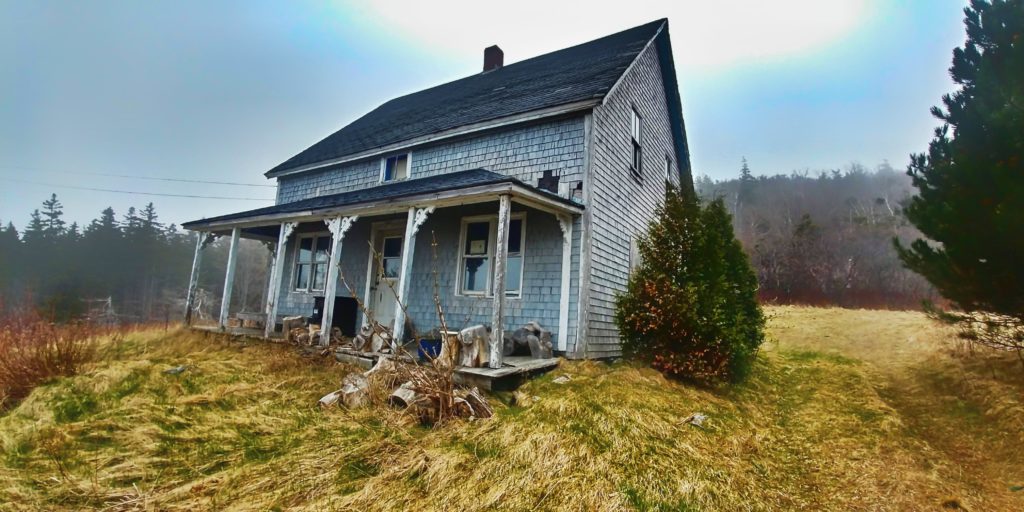
Putney House (as it looks today) was bought by Putney School for summer camps in 1948. Photo: Josh Thorne
Sadly, as the Cape Breton economy faltered throughout the 50’s and 60’s, local residents’ ability to generate a reliable income from their remote farms was limited. As a result of economic decline, many felt forced to sell their large family plots along the coast and move into towns and closer to the mines in order to survive. Concurrently, Carmelita encouraged other faculty and friends of the Putney School to purchase blocks of land in the Highlands as they became available. Indeed, even the Putney School itself purchased a plot.
Jean Rosner, Carmelita’s daughter, shared her mother’s passion for the Mabou Highlands. Jean’s daughter, Sara Rosner, tells a story of how the impetus for pro-actively preserving these large tracts of land for public use and non-development began. Apparently, back in 1957 Jean heard a rumour that a car salesman from Boston was planning to buy up Mabou Highland lands and build 1,000 vacation cabins that would each be privately owned or rented out.
Jean’s vision was that the land should be protected such that when people were on the shore “you shouldn’t feel like you’re in someone’s back yard” – no houses should be visible nor should highways, roadways or traffic. Jean felt strongly that the original sense of Cape Breton hospitality she’d encountered needed to be preserved and that open access to the Highlands and the ocean would be one way to reflect that generosity of spirit.
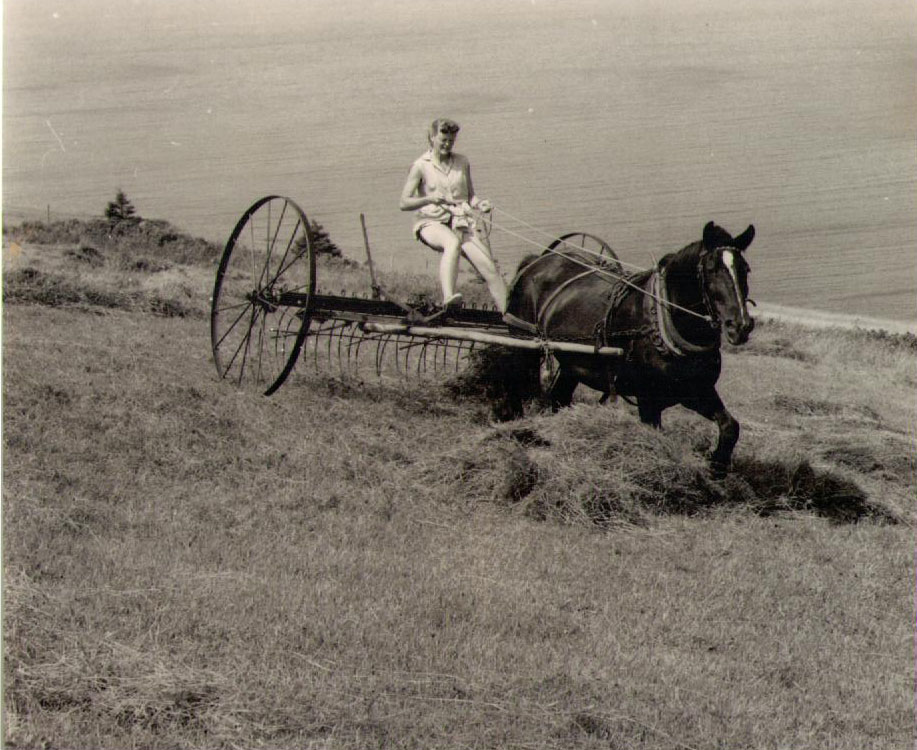
Historic photo of Jean Rosner in the fields of Sight Point.
At the time, Jean was able to get agreement from the Mayor of Port Hood that if she could get all six city councillors to agree to her proposal, she could buy the land at the same price the car salesman was offering for it. Given that the roads were very rustic at that time, plus few had telephones and today’s modern voicemail and messaging systems were not yet even thought of, it took her the entire summer to contact each councillor and negotiate an agreement. But she accomplished it and bought the lands to preserve their integrity and to guarantee accessibility by all. Besides the time and effort involved, this was not an easy accomplishment for Jean. She wrote to a friend at the time “I had to use the small amount of money I’ve saved to send my kids to college to buy the Mabou property.”
David Rumsey first discovered the Mabou Highlands for himself in the mid 1960’s. He became long-term friends with Jean Rosner, and she educated him in the need to preserve both the land and its heritage. Thus began an active drive to help ensure that other American landowners either created easements or sold their properties with preservation as the main objective. With the creation of the Nova Scotia Nature Trust in the late 1990s, a local organization with growing resources and a commitment to the natural environment gave renewed hope to the advancement of the project. Since then, David Rumsey has stepped up acting as a catalyst for the legal protection of the land.
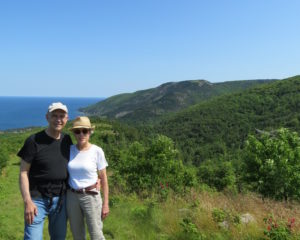
David Rumsey & Abbey Smith Rumsey on the MacKinnons Brook Trail.
A cartographic enthusiast, David has been involved in mapping the foundations of settler homes, and he’s thrilled that Nadine Hunt (of the Cape Mabou Trail Club)has begun to develop and install signage along the 25 km of trails through the area detailing the history and location of settlers. As David’s wife Abby Smith Rumsey points out, “knowledge is hard won and quickly lost”. Cultural history is an aspect of preservation that fascinates her; not only seeing the land preserved for the future, but ensuring that the stories of the place are kept alive as well. For Abby, who began visiting the area in 2002, being able to look down to the ocean and see acres and acres of wild roses in blossom is nothing short of magic. It’s a view that excites and soothes at the same time.
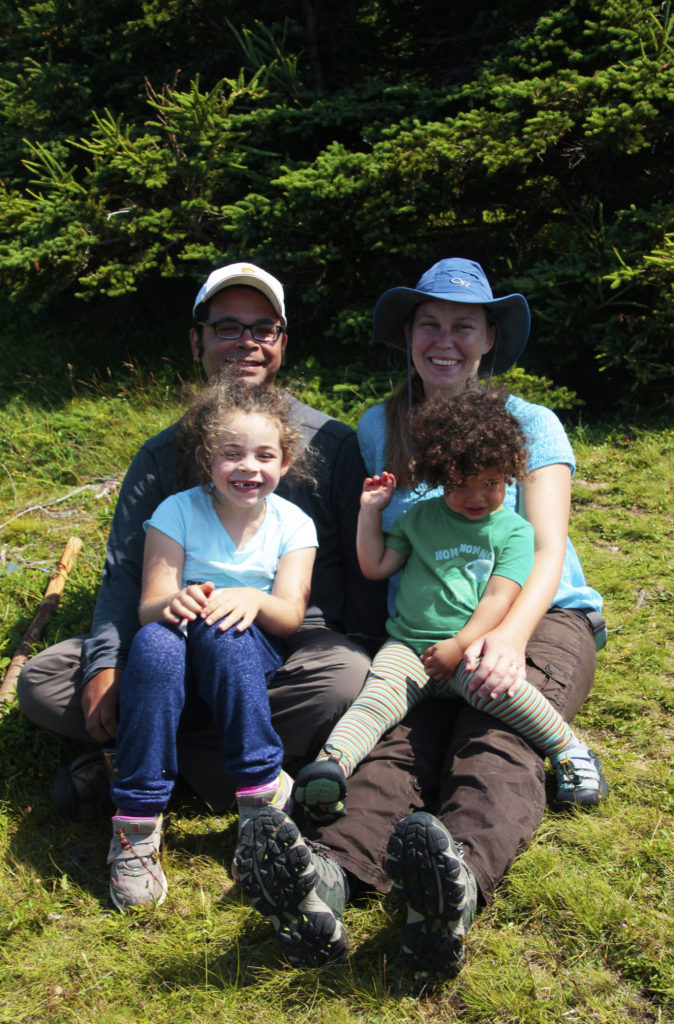
The next generation of Kinzers. Kristen Kinzer (daughter of Lee Ann & Bob) with her husband David and their children Eleanor & Olivia.
Lee Ann and Bob Kinzer, “just happened to be in the right place at the right time” when they found the Mabou Highlands by happy accident. Back in the early ‘70s Bob worked with someone who was from Cape Breton who directed them to the Mabou Highlands area. His Nova Scotian friend knew they had unsuccessfully searched the US East Coast extensively for affordable property, so he suggested they consider Mabou. The Kinzers were able to purchase 100 acres and were astounded that their land included an old homestead with ocean views. “We’ve now had 3 generations on this land,” says Lee Ann. “My 7-year old granddaughter loves the little red house we summer in. She doesn’t really know where Nova Scotia or Cape Breton is. But she knows ‘the little red house’ and anxiously awaits each and every visit.”
Bob Kinzer believes the magic of the Mabou Highlands’ landscape lies in its miniature mountain ecosystem with highly varied geology. “The coastline is exceptional, partly because not all of it is accessible. Add to that the cliffs, rocky areas and climax forests on the mountaintops and the region is remarkable with a lot packed into a small area”, says Bob. He’s also thrilled that it hasn’t been overused, and thanks to the involvement of the Cape Mabou Trail Club and Nova Scotia Nature Trust it never will be.
For others who’ve protected their lands in the Mabou Highlands, the allure is as simple as being able to relax in enjoy the freedom and joy of nature. Sharon Treat says “there’s no place that’s more important to me and my family than Sight Point [in the Mabou Highlands]. I spent every summer of my life there. My parents were school teachers who fell in love with the land and its people. As children we had lots of freedom to hike around, to get lost and find back roads, to swim out in the ocean.”
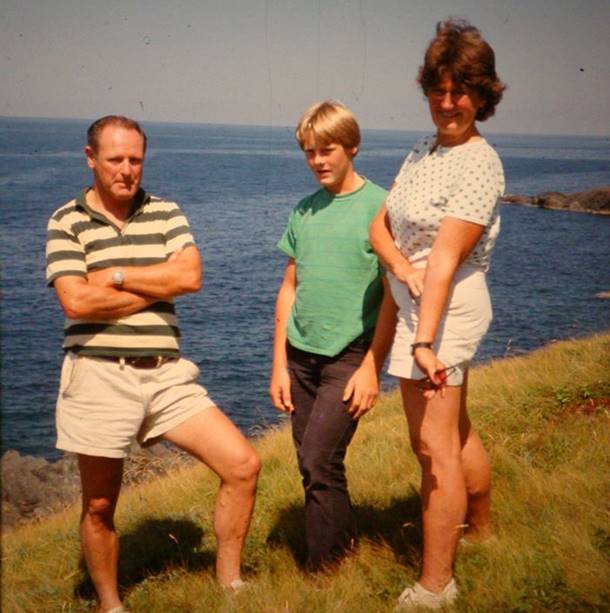
Summers at Sight Point – Bob, Rory and Mary Lou Treat. Photo contributed by Carolyn Treat.
Back when the Nature Trust was just a fledgling land trust with plenty of energy and passion, but an unproven track record in land conservation, the Treat Family chose to put their faith in the Nature Trust. Led by parents Bob and Mary-Lou, the Treat family protected two beautiful coastal properties through permanent conservation easement agreements in 2002. As the first American donors to give an easement to the Nature Trust (and one of the first easements of its kind in Canada), the Treats patiently endured a long, complicated and challenging cross-border process. All five children – Sharon, Carolyn, Jessica, Rory, and Roger, along with Bob’s wife Mary Lou, co-signed the conservation easement. It is no small feat to get that kind of cooperation (as anyone with a large family can attest!), especially on such a significant, complicated and emotion-laden issue as deciding the future of the family land.
For Sharon, who moved house frequently as her parents’ teaching contracts changed, the Mabou Highlands is ‘home’, the place that represents stability and long-term connection. She marvels at the fact that as children they each would find their ‘secret spots’ in the woods every summer, pitch pup tents and then sleep there at night. To this day Sharon loves kayaking the coast, often to hidden coves that are only accessible by kayak. She also recalls just how accepting the locals were of their small summer visitors; nobody shooed them away and they were frequent guests at local farmsteads.
Sharon also remembers just how important the vast quiet and solitude of the Mabou Highlands were for her the year she studied for her bar exams. Every day, for many weeks, she’d be found in her chair in the woods, studying away, hour after endless hour. Her daily reward was to get a swim in the ocean. The combination of nature, quiet and cooling ocean swims must have worked because Sharon passed those exams and went on to become an environmental lawyer!
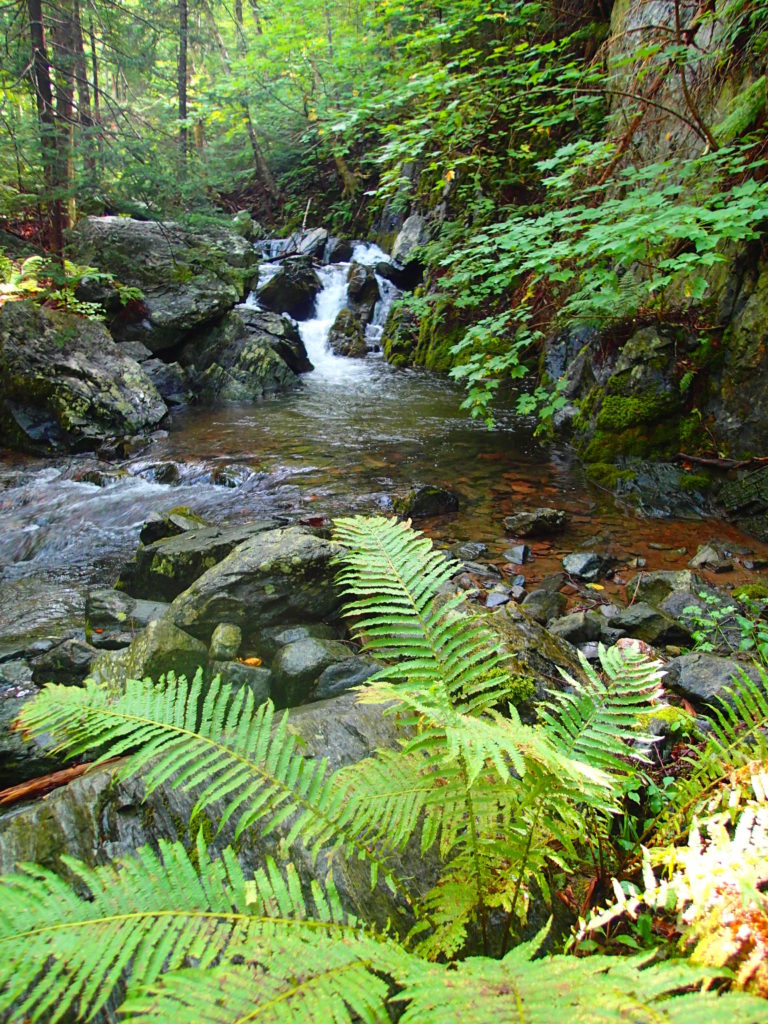
A brook running through land protected by the Walworth family.
Following the research and pioneering work required to finalize the Treat’s ground-breaking cross-border conservation easement, the Walworth family also protected their lands at Sight Point in 2011. Jim Walworth talks about the many discoveries he and his siblings made digging around the old farmhouse on their land. Finding old leather shoes, horse harnesses, jars and bits of old pottery really gave them a sense of the history of the land they were occupying. It made ‘the old days’ come alive. He particularly remembers one summer helping with a community project to repair a barn roof and how surprised he was to hear the locals chatting (and swearing) amongst themselves in Gaelic as they worked away.
Since Carmelita Hinton’s original purchase of land on Cape Mabou, preservation has been a critical aspect of this story. As David Rumsey has noted, he learned from Jean, Carmelita’s daughter, just how important preservation of both land and history is. When Jean passed in 2003 it was clear to David that he needed to step up and continue the work he’d been involved with her.
David has provided funding as well as negotiation efforts and coordination to support the Nature Trust team in acquiring the very significant land that is now the Mabou Highlands Conservation Lands. David has high hopes that funding will be found to continue to expand the protected areas in the Mabou Highlands. He believes strongly that the Nature Trust team has both the will and the professional capabilities to make this happen. He remembers his initial meeting with Bonnie Sutherland, Executive Director of the Nature Trust, on a rainy day way back in 1999. They came to an agreement that day to work together to preserve as much of these magical and precious lands as possible. It has taken a very long time, a lot of negotiation, good will and financial support to bring these 2,000 acres together, but it has finally blossomed into a resounding success!
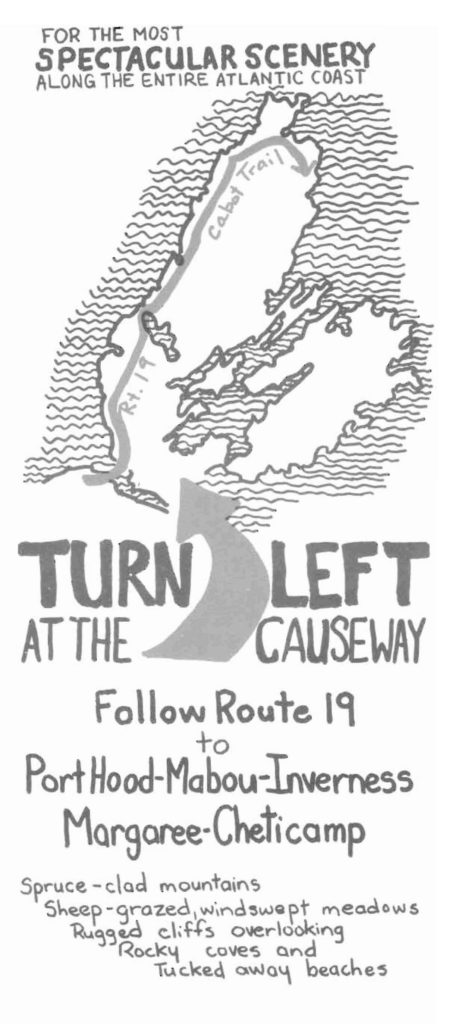
Jean Rosner’s “Turn Left at the Causeway” brochure promoting the beauty of the Mabou Highlands and surrounding area.
Jean Rosner was such a fan of the Mabou Highlands area that she created her own brochure to lure visitors to the area. “Turn Left at the Causeway” was distributed locally at her own expense. In it, Jean describes the area thus: “The scenery along the west coast of Cape Breton Island has a beauty all its own not found elsewhere on the Island. It is the special combination of mountain, meadow and sea which makes it unique. Here tile green farm meadows sloping down to the rocky coast accent the dark spruce forests of the hills and mountains.”
Thanks to many preservation-minded landowners, committed locals like Nadine and Ian who work through the Cape Mabou Trail Club, and now the Nova Scotia Nature Trust, these pristine mountains, forests, meadows, cliffs and seashore will remain available for future generations to enjoy. In a world rapidly succumbing to climate change, these Mabou Highlands Conservation Lands will help ensure that wildlife and natural landscapes remain undeveloped. Carmelita and Jean would certainly be proud to know that their desire for preservation has been honoured and built upon and that new generations are enjoying their legacy of accessible wilderness and wild ocean.
